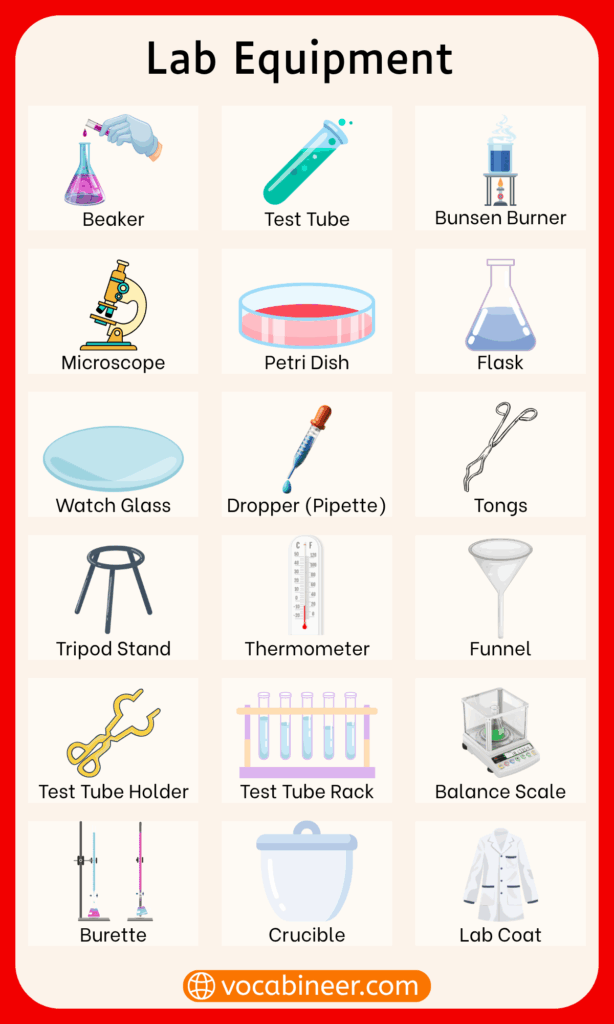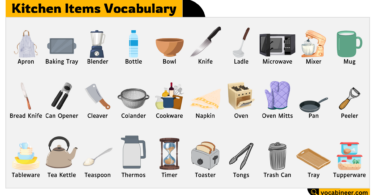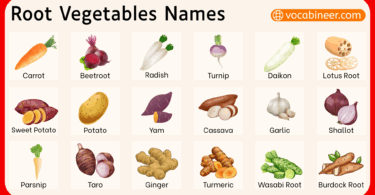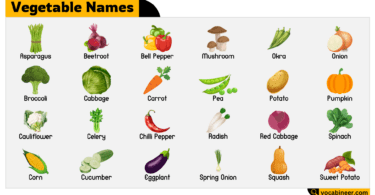Science labs use specialized tools and instruments to perform experiments and make observations. Learning the names of lab equipment in English helps students describe their work clearly and understand scientific processes better. Whether in chemistry, biology, or physics, each tool has a specific name and purpose. This guide lists essential laboratory apparatus used in schools and labs, grouped by subject and function, with pictures and examples to support vocabulary building.
In This Page
List of 50 Lab Equipment Names and their Pictures
This is a list of 50 common lab equipment names used in science labs. These tools are found in chemistry, biology, and physics experiments and are important for learning scientific work.
- Beaker
- Test tube
- Flask (Erlenmeyer)
- Conical flask
- Measuring cylinder
- Bunsen burner
- Tripod stand
- Wire gauze
- Test tube rack
- Test tube holder
- Funnel
- Dropper
- Pipette
- Burette
- Clamp stand
- Crucible
- Evaporating dish
- Watch glass
- Glass rod
- Spatula
- Tongs
- Reagent bottle
- Volumetric flask
- Mortar and pestle
- Balance scale
- Digital balance
- Stopwatch
- Thermometer
- Ammeter
- Voltmeter
- Galvanometer
- Spring balance
- Barometer
- Manometer
- Dissecting tray
- Scalpel
- Forceps
- Microscope
- Slide
- Cover slip
- Petri dish
- Staining bottle
- Safety goggles
- Lab coat
- Gloves
- Face shield
- Fume hood
- Eyewash station
- Fire extinguisher
- First aid kit

Common Laboratory Equipment Used in Science Labs
These are general tools found in most school science labs, used in many types of experiments regardless of subject.
- Test tube – small glass tube for mixing chemicals
- Beaker – wide container used to hold and heat liquids
- Flask (Erlenmeyer) – cone-shaped bottle used to swirl or heat solutions
- Graduated cylinder – tall tube used for measuring liquid volume
- Dropper (pipette) – transfers small drops of liquid
- Bunsen burner – gas flame used to heat substances
- Tripod stand – supports beakers or flasks above the burner
- Wire gauze – placed on tripod to hold glassware and spread heat
- Clamp stand – holds glass tubes and flasks in place
- Test tube rack – holds test tubes upright
Chemistry Lab Tools and Their Names in English
Chemistry labs require special tools for heating, mixing, measuring, and reacting substances. These items are key for chemical experiments.
- Crucible – small container used to heat chemicals at high temperatures
- Tongs – used to hold hot glassware
- Watch glass – shallow glass plate used to hold solids or cover beakers
- Funnel – helps pour liquids into containers without spilling
- Measuring flask (volumetric flask) – measures fixed volumes of liquids
- Test tube holder – clips that hold test tubes during experiments
- Reagent bottle – stores chemical solutions
- Evaporating dish – used to heat and evaporate liquids
- Desiccator – keeps chemicals dry and moisture-free
- Spatula – used to handle powders or crystals
Physics Lab Instruments for Students to Learn
Physics labs include measuring devices and instruments used to study light, electricity, sound, and motion.
- Stopwatch – measures time in seconds
- Voltmeter – measures voltage (electric potential)
- Ammeter – measures electric current
- Thermometer – measures temperature
- Galvanometer – detects small currents
- Barometer – measures air pressure
- Spring balance – measures force or weight
- Tuning fork – produces sound for experiments on vibration
- Pendulum – used to study motion and time
- Resistor – part of electric circuit experiments
Biology Lab Apparatus with Functions and Pictures
Biology labs involve the study of living things and use tools for examining cells, tissues, and organisms.
- Microscope – magnifies small objects and cells
- Slides – thin glass pieces that hold samples under microscope
- Cover slip – placed over specimens on slides
- Petri dish – shallow round dish used for growing bacteria
- Scalpel – small sharp knife used in dissections
- Forceps – used to hold or move small tissues
- Dissecting tray – surface where dissections are done
- Dropping bottle – holds and dispenses liquids
- Preserved specimens – stored animals or tissues used for observation
- Staining bottles – hold dyes used to color microscopic slides
Measuring Instruments Used in the Laboratory
Accurate measurement is important in every science lab. These tools help measure mass, length, volume, temperature, and time.
- Balance scale – measures mass (weight) of substances
- Measuring cylinder – measures volume of liquids
- Thermometer – measures temperature in Celsius or Fahrenheit
- Ruler – measures length
- Stopwatch – tracks time during experiments
- Digital balance – gives accurate digital reading of mass
- Measuring tape – used for longer length measurements
- Burette – measures precise amounts of liquids (often used in titrations)
- Pipette – measures and transfers small liquid volumes
- Manometer – measures pressure of gases or liquids
Glassware Items in a Science Lab
Glass tools are commonly used for mixing, storing, heating, and observing chemicals or samples.
- Beaker – used for holding and heating liquids
- Flask – used to mix or boil liquids safely
- Graduated cylinder – measures liquid volumes
- Test tube – small tube used for reactions
- Watch glass – shallow glass for holding samples
- Glass rod – stirs mixtures
- Measuring flask – accurately measures fixed liquid volumes
- Burette – for precise addition of liquids in titration
- Dropping bottle – holds and drops solutions
- Condenser – cools and condenses vapors in experiments
Safety Equipment Names Used in Laboratories
Safety is essential in every science lab. These items protect students and prevent accidents during experiments.
- Lab coat – protects clothing from spills
- Safety goggles – protect eyes from chemicals and flames
- Gloves – protect hands when handling chemicals or heat
- Face shield – covers the entire face for extra safety
- Fume hood – removes dangerous fumes from the air
- Fire extinguisher – used to stop small fires
- First aid kit – contains bandages and emergency items
- Eyewash station – used to rinse eyes if chemicals enter
- Heat-resistant mat – used under burners or hot tools
- Emergency shower – used for full-body chemical spills
FAQs About Lab Equipment Vocabulary in English
Every science student should know the test tube, beaker, flask, bunsen burner, and microscope.
They look similar, but pipettes are for measuring exact drops, while droppers are more general.
A fume hood removes toxic gases during experiments and keeps the air clean and safe.
A beaker has a straight shape and is good for holding liquids. A flask has a narrow neck and is better for mixing or heating.
No. In science labs, a thermometer is the correct tool to measure heat or cold.
Read More




